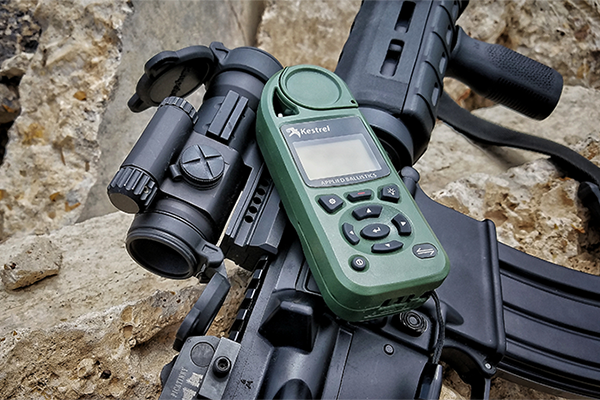
Last Updated on
By Kip Staton
I’ve always struggled with cold bore shots, and the culprit is almost always the wind. Frankly, my wind calling skills are not that great. Sure, after the first shot, I can walk things in fairly predictably. I even get lucky every now and then with a solid first round hit at distance.
But, up until recently, I have usually had bad luck connecting with that first shot. Normally, I try hard not to look to a new piece of gear to fix a problem I have with my shooting (see my months-long, daily 25-yard shooting project with a Glock 19 for proof.) But I’ve found that in some cases, the right piece of gear can turn out to be your best friend.
And the Kestrel 5700 Elite with Applied Ballistics is my new best friend for taking shots past 200 yards. This isn’t really a review of the device, rather, it’s a quick glance into how I use it, and how it fits into my rather inexperienced long range shot process.
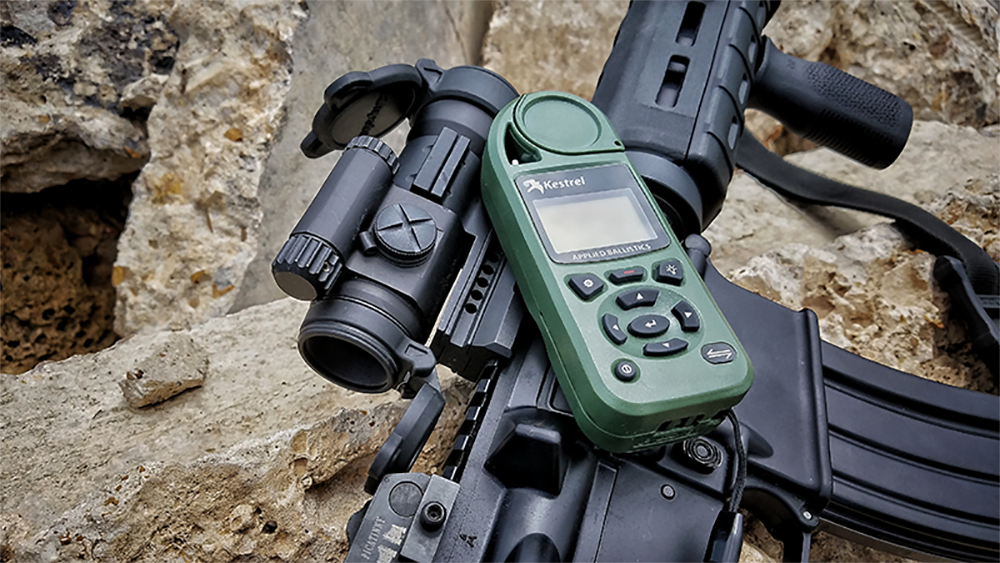
I’m not a professional rifle shooter. But I have access to some land that I’m fortunate enough to be able to shoot on during my lunch breaks.
I don’t shoot crazy amounts of ammo. But I do shoot often, which means I’m exposed to plenty of different weather and wind conditions. And the Kestrel Ballistics Meter allows me to shoot in all those different conditions without having to sweat the small stuff.
I’ve noticed that shooting often really makes the little, cumulative things that affect your shot more apparent. I probably wouldn’t have the chance to take much note of the influence that a miscalculation in something like barometric pressure makes if I only shoot past 400 yards once a year, in light of other things that may be going on with technique or gear.
But if I do it every day for a week, a little error like that becomes quite concrete, and manifests itself into a real question mark after a missed shot that “should” have been good.
The Kestrel 5700 Elite accounts for all of those little things. It seems like a complex device. In reality, it makes life much simpler.
My Gear Shakedown
Before we get into the details of the Kestrel 5700 Elite with Applied Ballistics, I think a brief overview of my gear is in order. On my own blog, I try really hard not to talk about gear. But here, I like to indulge a little.
When I’m not reviewing optics, my old standby SWFA Super Sniper rides on my Ruger Predator. It’s an old optic, hailing from the days when nobody was matching turrets and reticles. It’s a fixed 10 power. The mil-dot reticle has round dots.
It’s not high speed, and it’s definitely not low drag. But it tracks like a train, and the glass quality is good enough to see the things that need to be seen.
I’ll be straight up here: The Ruger is my only bolt action rifle. It’s my only .308. I don’t have a safe full of precision rifles. I don’t have a line of manufacturers beating their way to my door, guns in hand, breathlessly awaiting a review.
None of my cheap or outdated gear really matters anymore. It’s not fancy, but it works. On the gear side of things, I’ve found that ammo quality makes the biggest difference in getting hits. And I won’t say that nice gear doesn’t work better. But I’ve found the one thing that’s cleaned up my random misses far better than I could ever have hoped. And it’s not a new gun or scope.
It’s data.
Kestrel Makes it Happen
I use a Kestrel 5700 Elite Applied Ballistics for any shot taken past about 200 yards. It’s just too easy not to. Wind calls, drop data, it’s all there. And all constantly being updated live, keeping up with the atmospheric conditions around me. I’ll even pull it out when I’m shooting my non-free floated carbine with an Aimpoint. I’m addicted.
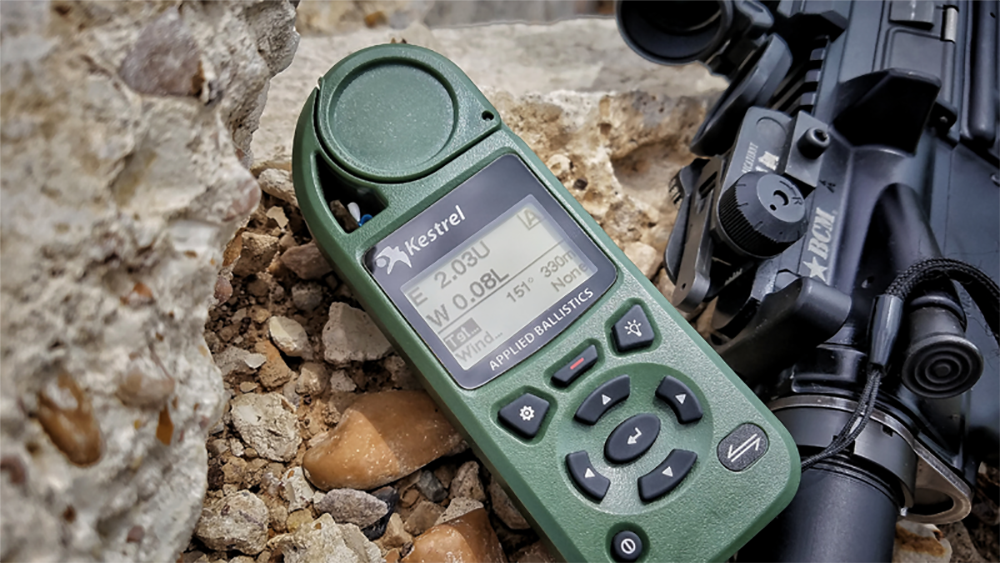
I used to just use the Strelok app to find my holdovers, and used average atmospheric conditions to make things simple. It at least felt like I was compensating for those details, in a general way. But the Kestrel and built-in Applied Ballistics software calculates each of these variables and applies them to your solution, for each shot.
Yes, you can get by with just a wind meter, without the ballistic solution solver built in. I think it would be kind of a pain to constantly update your tables to match current conditions, and then juggle a meter, your ballistics app and a rangefinder. There is a distinct elegance in using one tool after getting the range to your target.
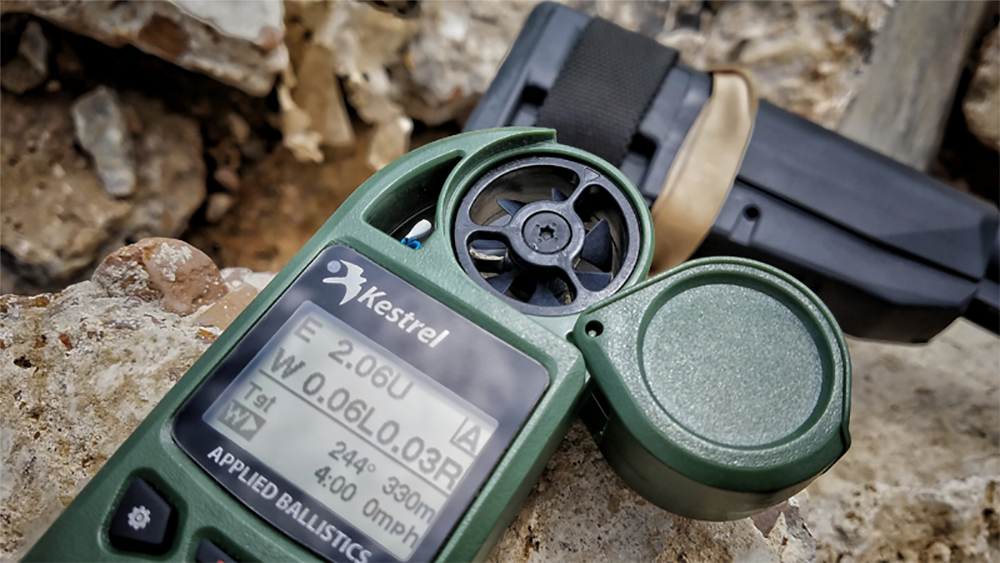
Before I started using the Kestrel, I didn’t know just how much simpler an advanced tool like this can make things. After getting some time with it, I just don’t see how I could go back.
The Kestrel 5700 Elite with Applied Ballistics
This is a military grade device. You can immediately tell that the housing is made to handle life in the field just by picking it up: It’s a thick polymer material. This version has been upgraded by Kestrel from previous models: The battery compartment is separate from the electronics, and sealed to prevent any battery leaks from damaging the electronics.
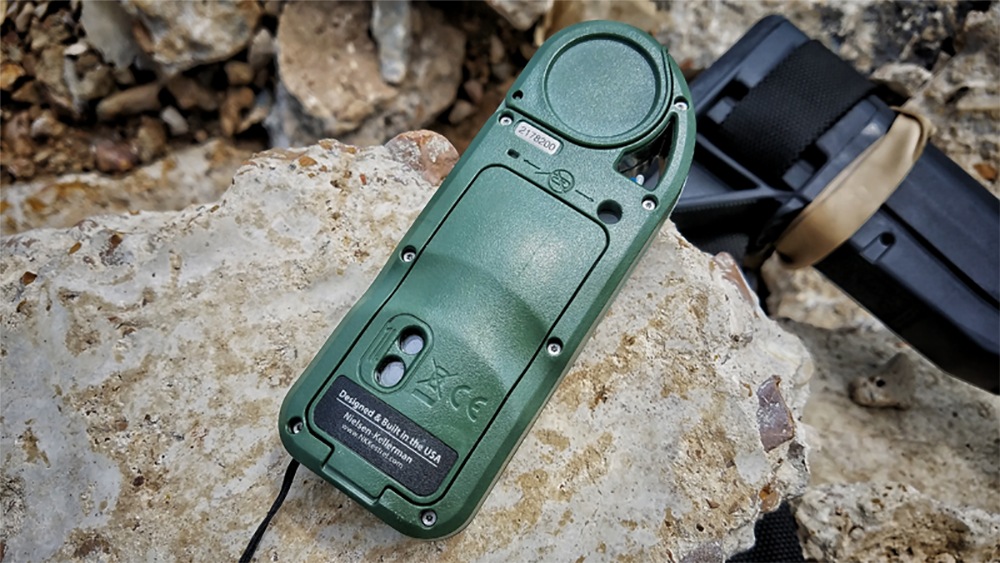
Thankfully, Kestrel chose to run the Elite 5700 from a standard AA battery, instead of a rechargeable internal or proprietary cell. Battery life is long, but it’s nice to be able to top off or replace the power source without being tied to a power outlet.
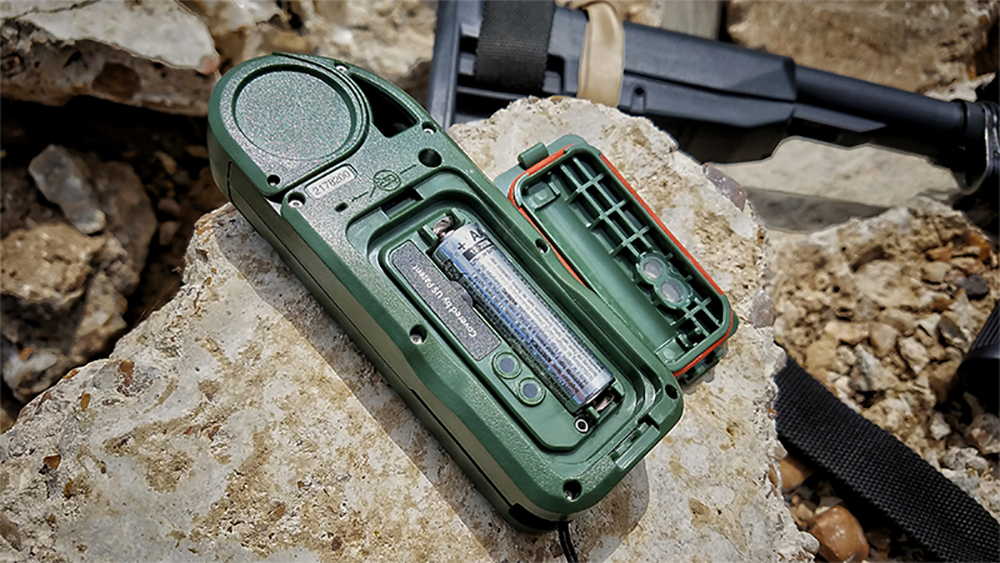
The 5700 Elite is also available in desert tan, olive green, blaze orange, or black. Mine is in olive green, which matches a lot of my gear. It’s pretty neutral. Kestrel also includes a comprehensive instruction manual, cloth carrying bag, and lanyard with the meter.
Ranging
The only thing the Kestrel 5700 Elite doesn’t do for you is estimate range. Granted, it does have a calculator that allows you to derive the distance to your target if you know its size and are handy with measuring with your reticle. This is convenient, but it isn’t really anything groundbreaking, and comes with the drawbacks associated with this method. Measuring targets to the 10th mil is difficult without specialized reticles, and even then it takes practice.
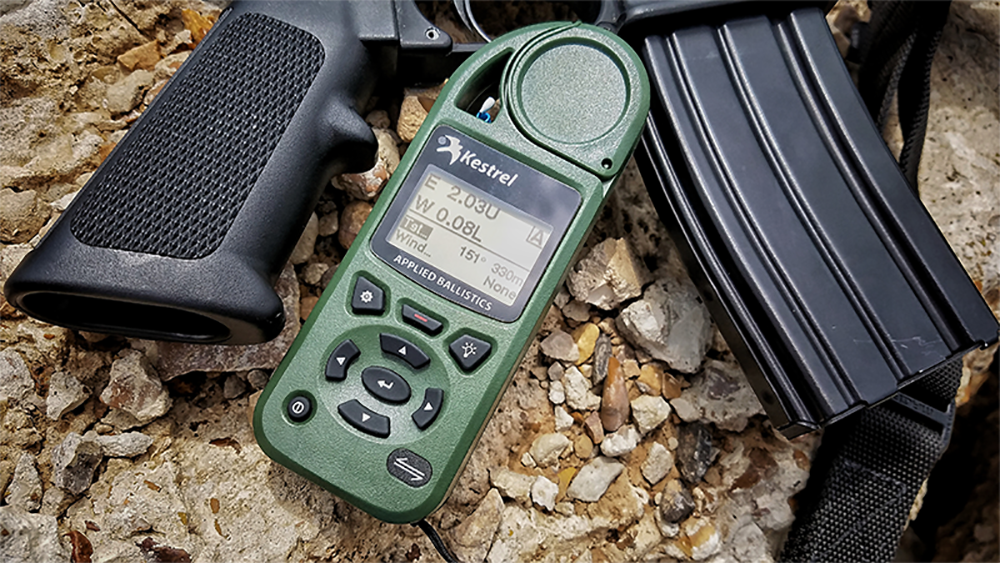
I do have an older Bushnell rangefinder I occasionally use, but it’s only good under perfect lighting conditions, and on larger semi-reflective targets. I’ve never been able to get it to range to the advertised distance, but it’s a cheaper model with lower quality receiving mirrors. It works really well at distances 400 yards and in, though.
My favorite method for calculating distances is with the Measure Map app, on my Android phone. It uses Google maps and your phone’s GPS to calculate the distance between your location and an endpoint (or any two points, for that matter).
I’ve measured it against known-distance ranges and my rangefinder, and have found that it’s accurate within a meter or so. It’s fast, accurate, and free. I even ponied up a couple dollars to remove the ads along the bottom edge. Because if I’m using satellites to help shoot targets hundreds of yards away, it’s gotta be ad free.
The only downside to using a mapping app like this to calculate your range is that it only works as long as you have cell service. AT&T hasn’t let me down yet, but I keep my rangefinder and reticle handy just in case.
Making the Shot
Like I mentioned, this model is equipped with Applied Ballistics software, and I would consider it almost mandatory for anybody even mildly serious about shooting long range. The 5700 Elite isn’t just a wind meter. It’s a full ballistics solver, with plenty of cool features up its sleeve.
Setting up the Kestrel 5700 Elite can be intimidating, and is honestly something you want to do with the instruction manual in hand. Just follow the directions while inputting all of your rifle and ammo details, and you’ll be fine.
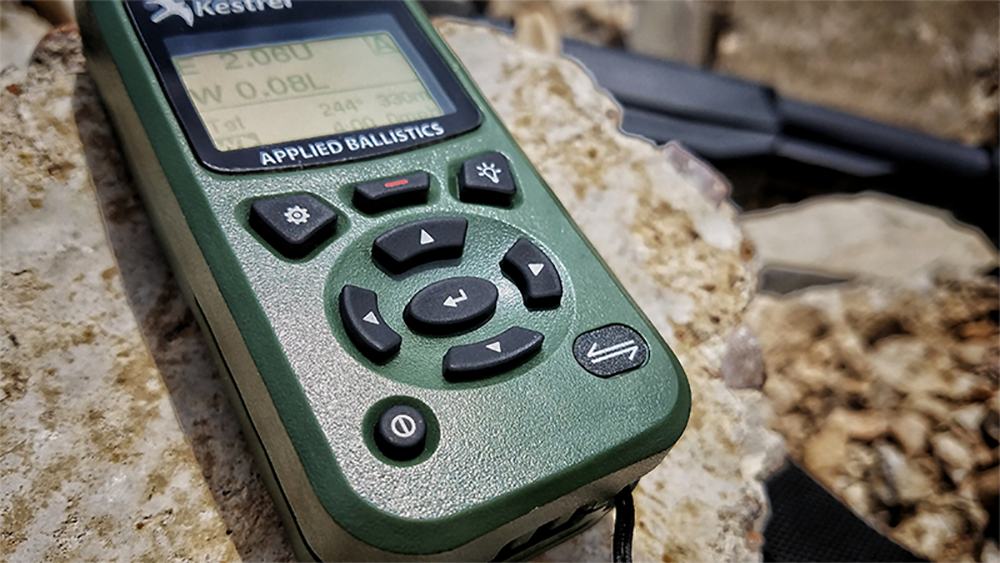
If you have the opportunity, you should definitely take advantage of the muzzle velocity truing feature. This allows you to calibrate the meter to your actual muzzle velocity, based on real-world results down range. If you think your bullet is moving at 2800 feet per second (for instance), but you impact low at 600 meters, logging the error into the meter will correct for anything that’s changed from your last chronograph test and predict your true muzzle velocity. It’s a very cool part of the system.
I prefer an uncluttered shooting experience. Once I’ve thrown down a heavy tarp to lay on, all I need around me is my Kestrel, ranging method, ammo and any shooting bag I’m using under the butt of the gun. Simple is good.
After I have everything ranged, dialed in, and have taken wind measurements, it’s time to take the shot.
Conclusion: Do You Need a Kestrel Wind Meter?
We really live in a unique era. Guns and ammunition that anybody can afford are readily available, and perform remarkably well. It’s uncommon to find a new bolt gun these days that won’t shoot around an inch or so at 100 meters, with good ammo. Optics aren’t far behind. The very fact that a regular guy like me can afford a rifle and optic that are high quality enough to allow sophisticated use of a device like the Kestrel Elite 5700 is really astounding, if you think about it.

I don’t want to sound like I’m gushing over the Kestrel. But perhaps I can’t help it. It’s the premier solution for finding the answers to ballistics problems in the field. In my opinion, anything else would be a compromise.
It’s a very beefy link in the entire system of rifle, scope, range finding and fundamentals. Let’s not kid anybody, though: The Kestrel is a small piece of gear that costs more than my rifle and optic put together. It’s definitely a luxury item. But some luxuries are totally worth it.




Leave a Reply